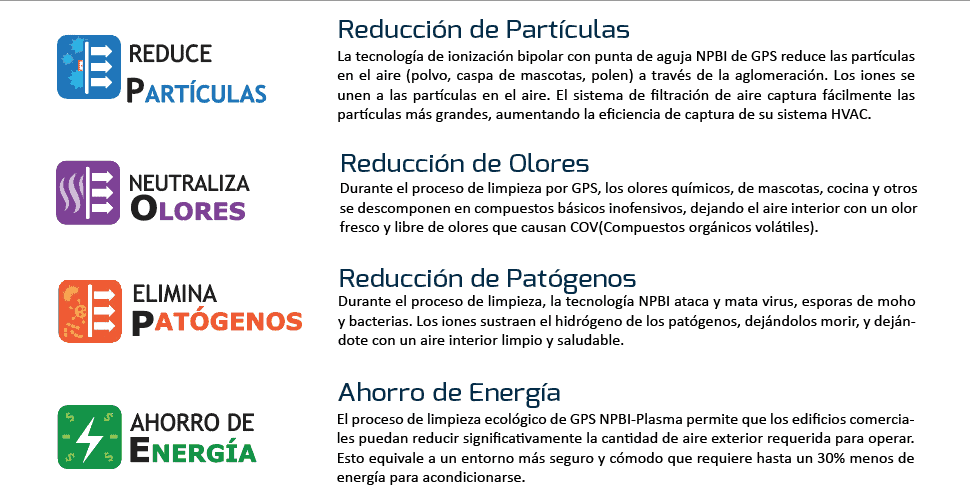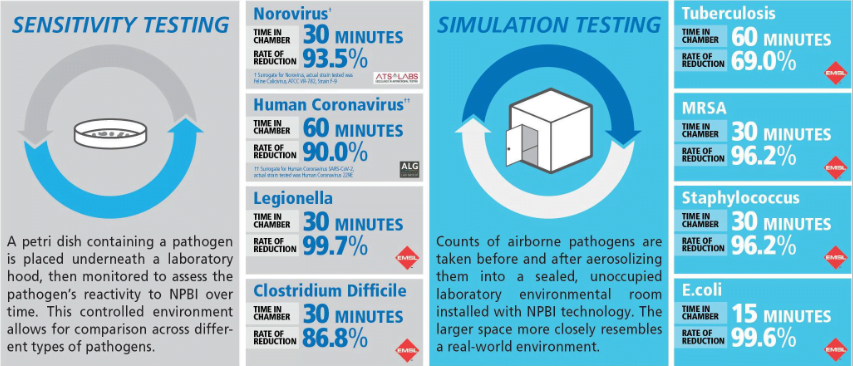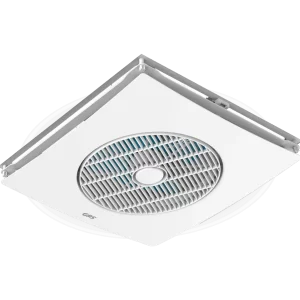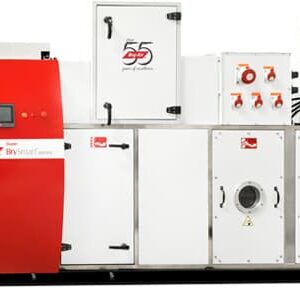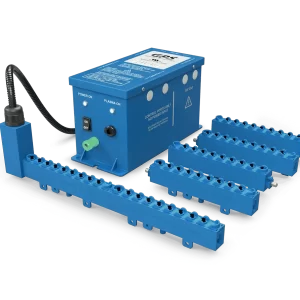Description of FC24
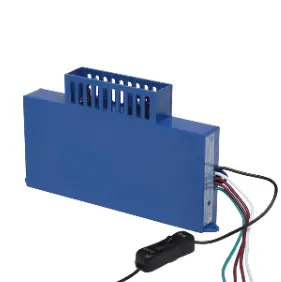
The FC24 is a self-cleaning, lightweight needlepoint bipolar ionization (NPBI™) system capable of handling up to 2,400 CFM or 6 tons. It is designed for multiple mounting options, including fan inlet, interior duct walls, or floors.
Description of IDF-2
- Benefits of the Pre-insulated Panel
- Specifications
- Application-specific Solutions
- Multi-Voltage Input: 24 VDC, 24–240 VAC
- >300 Million +/– Ions/cc
- Programmable Self-Cleaning Cycle
- Carbon Fiber Brush Emitters
- Integrated Alarm Contacts for Building Automation System (BAS)
- UL 2998 Compliant
- CARB compliant
- UL 2043 compliant
- FCC compliant (Part 18)
- Input Voltage24–240 VAC
- Amps0.170–0.017A operating / 0.33–0.03A cleaning cycle
- Power4 watts operating / 8 watts cleaning cycle
- Frequency50/60 Hz
- Total Ion Output> 300M ions/cc
- Airflow Capacity0–2,400 CFM or up to 6 tons
- Temperature Range–20° F to 140° F
- Humidity Range0–100% RH
- Unit Dimensions7.9″L × 1.1″W × 5.0″H
- Unit Weight1.25 lbs
- Electrical ListingsUL, cUL
- Alarm Contact Rating250 VAC / 1A, N.O. “dry” contact
- Compliance & CertificationsUL 2998, UL 867, IAQP, CE, CARB
GPS NPBI Plasma can be installed in any system in any building:
- building
• Hotels
• Hospitals
• Institutions
• Manufacturing
• Office Buildings
• Stores
• Schools and Universities
• Religious Centers
Private Transport
Public Transport
• Theaters and Cinemas
Agriculture
• Airports
• Animal Care
• Fields and Stadiums
• Banks
•Casinos
• Daycares
• Nursing Homes
• Convention Centers
• Gym
• Consultancies
•Restaurants
P.O.P.E system
We implement a P.O.P.E system that allows us to deliver and categorize our potential benefits when using our technology.

GPS Air's NPBI Technology NPBI Technology
The patented technology uses an electronic charge to create a plasma field filled with a high concentration of positive and negative ions. As air passes through the ionization field, harmful compounds break down into one or more of the four basic elements: oxygen, nitrogen, carbon dioxide, or water vapor.
When entering the ionization field, positive and negative ions surround harmful ammonia particles, breaking them down into hydrogen and nitrogen, which are naturally present in the atmosphere.
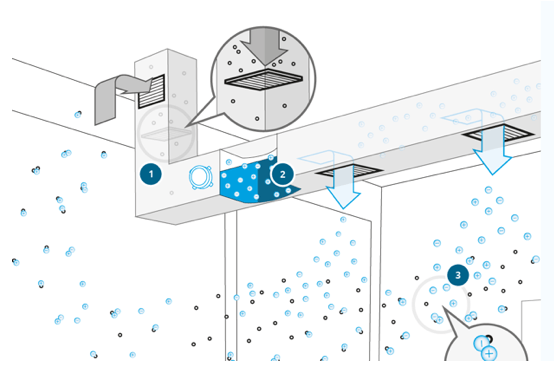
- Air passes through the ducts of the existing HVAC system and through the GPS ionizer.
- The ionizer produces positive and negative ions that are carried in the airflow through the ducts into the rooms.
- These ions seek out particles and combine with them, forming larger groups that the HVAC system's filter can more effectively capture.
This reduces suspended particles and improves indoor air quality (IAQ).
Clients already benefiting from GPS Air

Frequently Asked : Questions (FAQs)
- Produces no harmful byproducts
- Reduces particles in the air
- Reduces odors
- Deactivates pathogens (viruses, bacteria)
- Reduces energy costs
- UL 2998 certification without ozone
- Treats room air
- No replacement parts
- Improved indoor air quality (IAQ)
- Automatic self-cleaning
- Static electricity control
- Reduces allergens
- Easy to install, compact, and adaptable to all applications
- Low total cost: saves on construction and renovation costs
- Reduces maintenance
- Keeps new cooling coils clean and cleans old coils
- Offers P.O.P.E (Particle reduction, Odor reduction, Pathogen reduction, and Energy savings)
Needlepoint Bipolar Ionization, also known as "NPBI," is an artificial generation of
positive and negative ions without the production of ozone or byproducts.
As air passes through the product, our Needlepoint Bipolar Ionization (NPBI) technology
uses an electronic charge to create a plasma field filled with a high concentration of positive and
negative ions. As these ions travel with the airflow, they adhere to particles, pathogens, and gases.
he ions help aggregate fine submicron particles, such as dust or pollen, making them
unable to pass through the filter.
In short, NPBI technology: 1. Reduces particles 2.Reduces pathogens, mold spores, and viruses
Converts VOCs (odors) Replaces ultraviolet lights for coil cleaning Allows for reduced air exchange.
reduced air exchange.
The ions kill pathogens by stealing the hydrogen that sustains their life. The ions break down harmful VOCs
with an electron potential voltage below twelve (eV V <12) into harmless compounds like O2,
CO2, N2, and H2O. The ions produced travel within the airflow to occupied spaces, cleaning the
air wherever the ions travel, even in invisible spaces.
An ion is a molecule or atom that has a positive or negative charge, meaning it has electrons to
give or needs electrons to discharge, becoming stable.
Normally, small ions have a lifespan of about 60 seconds before they touch a surface
or particle to discharge.
GPS products with universal input voltage mean the unit will operate on any voltage in
the range of 24 - 240 VAC or DC. The self-cleaning product line detects the input
voltage automatically, and the internal circuitry adapts to the voltage. The GPS-iMOD power supply comes with a
built-in selector switch. The GPS-iRIB operates on voltages between 110-240 VAC.
GPS technology does not generate electrical noise and does not generate electromagnetic forces (EMF).
GPS technology is the only ionization technology approved by the FAA for installation on aircraft,
as it passes strict DO-160 certification, demonstrating that there is no line noise
or electromagnetic field that could be harmful to aircraft avionics if produced.
Humidity does not affect ion output; however, if water condenses on the needle tips,
the ions cannot emit, and ion output will be significantly reduced or cease.
Our NPBI technology complies with UL 867 or UL 2998 to ensure that harmful levels of ozone are not produced.
Touching the emitter brushes will produce a mild to moderate electrical shock. It is not recommended.
Normally, small ions have a lifespan of about 60 seconds before they touch a surface
Check the indicator lights on the power supply units DM48, FC48, iRIB, and iMOD (not on the module itself), call the installer, or purchase one of our sensors.



